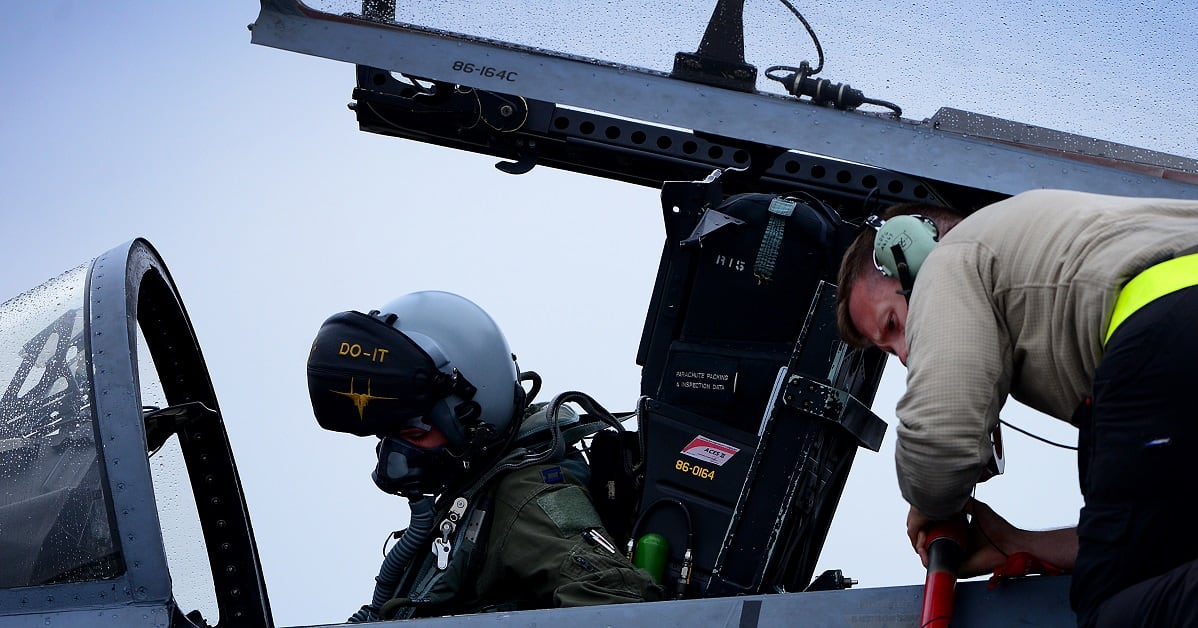KADENA AIR BASE, Japan — On the cloudy afternoon of Feb. 14, maintainers were hard at work on the flight line of Kadena Air Base, Japan, trying to get an F-15 Eagle ready to fly again.
A team of four maintainers rolled up their sleeves, pulled out the jet’s hydraulic pump and connected the aircraft to a system that would remove excess air, which can cause controls to malfunction.
The aircraft could be cleared to resume flight operations in as little as a half hour, said Staff Sgt. Johnny Brown, a dedicated crew chief from Kadena’s 18th Maintenance Group, which oversees sustainment of the base’s 54 F-15s, 15 KC-135 tankers, two E-3 airborne early warning aircraft and nine HH-60 Pave Hawk helicopters.
Click here to read more coverage from Kadena Air Base!
Like many other bases in the continental U.S. and abroad, Kadena Air Base’s F-15 enterprise is grappling with pilot shortages and challenges in retaining its skilled maintainers, but the base’s location on the Japanese island of Okinawa gives those challenges a unique flavor.
The Air Force has made huge progress in closing its maintenance deficit, which is down to a shortfall of 200 maintainers from about 4,000 positions. However, many of its maintainers are relatively green, and the service has resorted to novel methods to get them up to speed, such as training with retired aircraft from the boneyard at Davis-Monthan Air Force Base in Arizona.
At Kadena, that problem is exacerbated even further.
RELATED

Maintainers at stateside bases will work on the F-15 for four to five years, giving them time to become experts, Brown told Defense News in a Feb. 14 interview. Meanwhile, the 18th Maintenance Group has the numbers it needs to sustain the wing’s aircraft, but those maintainers often come in without a lot of experience and are out the door in two years.
“We have the maintenance [manning] to support it, but the most stringent part is just getting the training done as we support the mission. Because we still have to make sure the jets are ready for the pilots when they get there, as well as training our airmen in an efficient manner and a good time frame,” he said.
“It can be complicated sometimes, but we still get the mission done.”
The work seen by Defense News in February was carried out by three young, relatively inexperienced airmen and overseen by one seasoned maintainer. That’s very often the norm at Kadena, Brown said.
Over the next three months, 19 new maintainers will arrive at the base and will have to dive headfirst into making sure the 18th Wing’s aircraft are repaired and mission-capable, he said.
“We constantly get new people and are pushing people out,” he said. “These guys are pretty good at learning stuff, but like I said, you got different types of learning styles. You’ve got to make sure you train everybody by their learning styles and keep them efficient.”
On the operations side, the Air Force remains about 2,000 pilots short of what it needs — a level that, if it continues, could “break the force,” according to Air Force Secretary Heather Wilson.
For Kadena Air Base, the pilot shortage is more an administrative burden than a major obstacle. The base is home to two F-15 squadrons, the 44th and 67th, each of which has about 25 Eagles at its disposal.
Lt. Col. Nicholas Register, who commands the 44th Fighter Squadron, acknowledged that the pilot shortage is affecting his squadron, though he declined to lay out how many pilots it needs.
What it translates into for pilots, however, is a high-operational tempo.
From Monday through Thursday, the 44th will put up at least two groups of flights, which amounts to about three to five flights a week for each pilot. Each flight could be as short as 45 minutes or as long as two hours, said Capt. Brock McGehee, an F-15 pilot from the 44th.
The squadron expects an influx of new members over the next four or five months. Register sees that as a sign that shows Air Force efforts to boost pilot numbers ― such as monetary bonuses and regulatory changes that scale back operators’ administrative workloads ― are bearing fruit.
“I think we’re in the normal ebb and flow of personnel in and out of the squadron, and the way that things [look] right now, it looks like we’re going to have everybody that we need. We’re almost there,” he said.
Valerie Insinna is Defense News' air warfare reporter. She previously worked the Navy/congressional beats for Defense Daily, which followed almost three years as a staff writer for National Defense Magazine. Prior to that, she worked as an editorial assistant for the Tokyo Shimbun’s Washington bureau.







